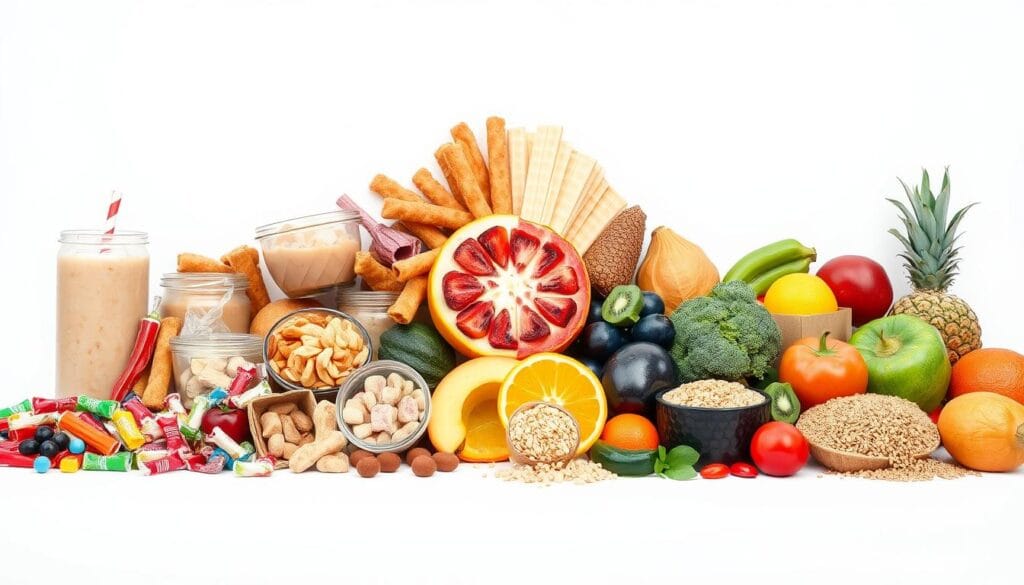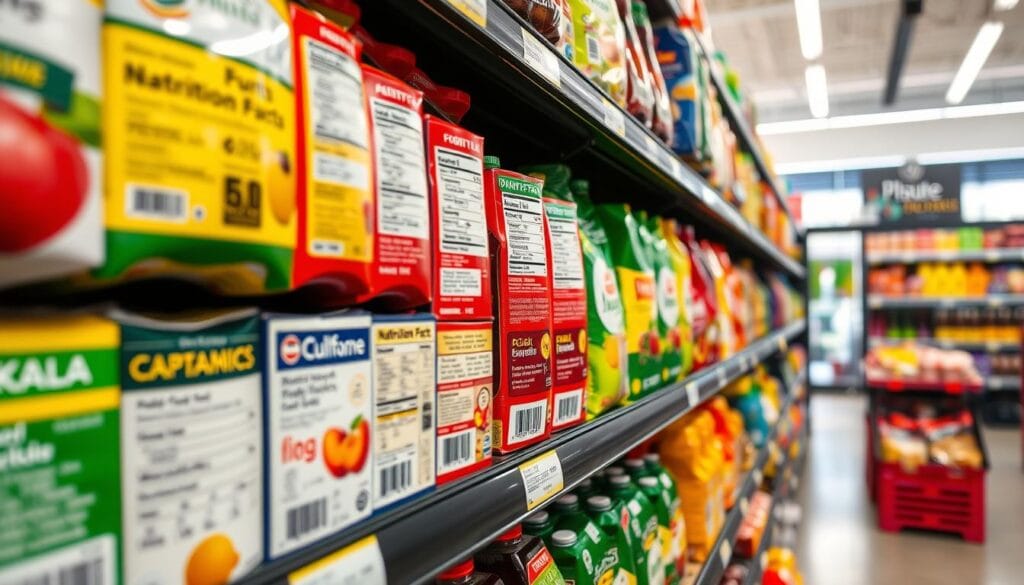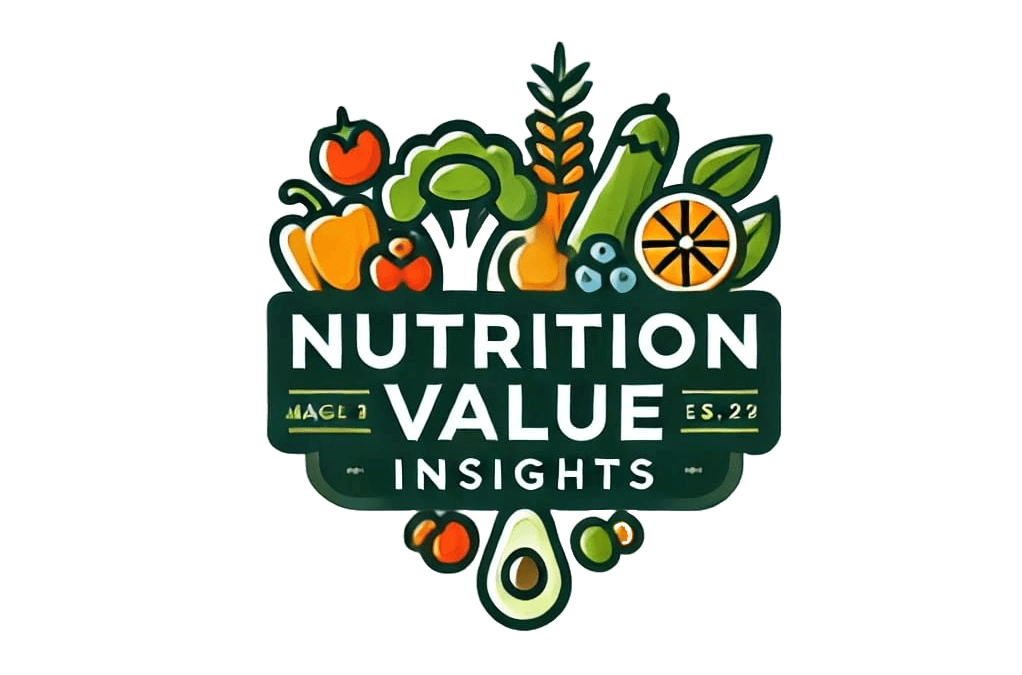What Are Empty Calories? Foods to Avoid and Healthier Alternatives
Empty calories are foods that give energy but have little nutrition. They are often full of added sugars, saturated fats, and calories. But they lack important vitamins, minerals, and nutrients. Eating too many empty calories can cause weight gain and increase the risk of chronic diseases.
It’s also important to know that they can lead to nutritional deficiencies. Knowing which foods are empty calories and finding better options is key. This helps keep your diet balanced and supports your health and wellness goals.

Table of Contents
Understanding Empty Calories
“Empty calories” are foods and drinks that give a lot of energy but don’t have much nutritional value. They usually come from added sugars, refined carbs, and unhealthy fats. Unlike whole foods like fruits, veggies, whole grains, and lean proteins, they don’t offer much good.
Definition of Empty Calories
Empty calories give energy but don’t have vitamins, minerals, fiber, or protein. Eating too many of these can lead to weight gain and obesity. They often don’t give the body the nutrients it needs to work well.
Sources of Empty Calories
The main sources of empty calories in our diet are sugar-sweetened beverages, processed snacks, and baked goods. These items are often full of added sugars, refined carbs, and unhealthy fats. But they’re low in nutrients, fiber, and other good stuff.
Examples of empty calorie foods and drinks include soda, sports drinks, juice, chips, cookies, cakes, and fried foods. Eating these nutrient-poor foods can increase your calorie intake without giving you the nutrients you need for health.
On the other hand, nutrient-dense foods like fruits, veggies, whole grains, lean proteins, and healthy fats offer a better balance of calories and nutrients. Adding more of these nutrient-dense foods to your diet can help you stay healthy and support your overall well-being.
Why Empty Calories are Harmful
Eating too many empty calories can hurt your weight control. These foods are full of calories but lack nutrients and fiber. This can make you feel hungry and lead to overeating and unintentional weight gain.
Also, not getting the right nutrients can harm your health. This can make you feel unwell and affect your overall well-being.
Impact on Weight Management
To lose weight, you need to eat fewer calories than you burn. But empty-calorie foods don’t have fiber, protein, vitamins, or minerals. This makes it hard to feel full and can cause weight gain.
Health Risks Associated with Empty Calories
Eating too many empty calories can lead to serious health problems. These include obesity, type 2 diabetes, heart disease, nonalcoholic liver disease, gout, and certain types of cancer. This is because these foods are high in added sugars, unhealthy fats, and refined carbs.
Alcohol is also a big source of empty calories and can cause weight gain. Just two small glasses of wine or two beers can be almost 10% of your daily energy needs.
By watching your caloric intake and choosing nutrient-dense options, you can improve your meals. This supports your health and well-being.
Common Foods High in Empty Calories
In the American diet, foods like sugar-sweetened beverages and sugary treats are big culprits of empty calories. These items are packed with added sugars, refined carbs, and unhealthy fats. They offer a lot of calories but little to no nutritional value.
Sugar-Sweetened Beverages
Soda, sports drinks, and energy drinks are full of empty calories. A single 12-ounce can of soda has about 39 grams of added sugar. That’s almost 78% of the daily limit. Drinking these regularly can lead to weight gain, type 2 diabetes, and other health problems.
Candy and Baked Goods
Enjoying candy, cookies, cakes, and other sweets can also add too many empty calories. These treats are often made with refined flour, added sugars, and unhealthy fats. For example, a medium-sized soft pretzel has about 80 grams of carbs, which is 29% of the daily intake. It’s key to eat these foods in small amounts to keep your diet balanced.
| Food Item | Carbohydrates (grams) | Percentage of Daily Recommended Intake |
|---|---|---|
| 12-ounce can of soda | 39 | 78% |
| Medium soft pretzel | 80 | 29% |
| Medium order of fries from McDonald’s | 43 | 15% |
It’s crucial to watch how much sugar-sweetened beverages, candy, and baked goods you eat. This helps keep your diet healthy and avoids the risks of too many empty calories.
Healthier Alternatives to Empty Calorie Foods
To cut down on empty calories, add more whole foods to your diet. Choose a variety of fruits, vegetables, whole grains, lean proteins, and healthy fats. These foods are full of vitamins, minerals, and fiber. They help keep you healthy and full, making it easier to stay at a healthy weight.
Nutrient-Dense Whole Foods
Go for a wide range of whole foods, such as:
- Fresh fruits like apples, berries, and citrus fruits
- Crisp vegetables like leafy greens, carrots, and bell peppers
- Whole grains like brown rice, quinoa, and whole wheat bread
- Lean proteins such as grilled chicken, fish, and legumes
- Healthy fats from avocados, nuts, and seeds
These foods give your body the nutrients it needs. They also keep you full and energized all day.
Swapping Sugary Drinks for Water and Unsweetened Beverages
Switching to water or unsweetened beverages is a simple way to cut down on empty calories. Water is calorie-free and keeps you hydrated. Unsweetened coffee, tea, and infused waters add flavor without the sugar and calories of commercial drinks. This change can greatly reduce your calorie intake and boost your health.
By choosing nutrient-dense whole foods and avoiding sugary drinks, you make healthier choices. These choices nourish your body and support your well-being. Remember, finding the right balance and enjoying a variety of foods is key to a balanced diet.
Empty Calories and Weight Loss
For those trying to lose weight, cutting down on empty calories is key. These foods are full of calories but lack nutrients, leading to weight gain and health problems. Eating more whole foods and less empty-calorie items helps you lose weight. This way, you can keep your health in check while shedding pounds.
Strategies for Reducing Empty Calorie Intake
To cut down on empty calories and reach your weight loss goals, try these tips:
- Practice portion control: Pay attention to how much you eat, especially with foods like sugary drinks and baked goods.
- Read nutrition labels: Look at food labels to spot and avoid empty-calorie foods.
- Swap sugary drinks for water and unsweetened beverages: Choose water, herbal tea, or infused water over sugary drinks to cut down on sugar.
- Prioritize nutrient-dense whole foods: Eat a variety of fruits, vegetables, whole grains, lean proteins, and healthy fats to get the nutrients you need while watching your calorie intake.
- Gradually make sustainable changes: Don’t try to change everything at once. Start with small steps, like swapping one sugary snack for a piece of fresh fruit each day.
By using these strategies and making smart food choices, you can lower your empty calorie intake. This helps you create a calorie deficit that aids in weight loss. You can do this without harming your health or well-being.
Striking the Right Balance
Moderation is key for a healthy lifestyle. It’s important to limit empty calories but also enjoy a balanced diet with treats. Cutting out all high-calorie foods might not be healthy or doable for everyone.
Finding a balance is the goal. Eat mostly whole, nutrient-rich foods. But, also enjoy small portions of treats now and then. This way, you can reach your health goals without feeling left out.
The Role of Moderation
The 80/20 Rule suggests 20% of your meals can be less healthy. This flexible diet leads to better weight management and mental health. It’s better than strict diets.
Enjoying your favorite foods in small amounts is okay. Focus on eating lots of fruits, veggies, whole grains, and lean proteins. This balance helps keep you healthy, boosts energy, and improves overall health.
The aim is not to deny yourself food. It’s about finding a balanced way to eat that suits you. With a balanced diet and treats, you can enjoy your favorite foods while staying healthy.

“Moderation, not deprivation, is the key to a healthy and sustainable lifestyle.”
Empty Calories
Empty calories are a big problem in the American diet. These foods give energy but lack important nutrients like vitamins and fiber. Eating too many empty-calorie foods can lead to weight gain and health issues.
American snack habits are concerning. People eat about 400 to 500 calories from snacks every day. Often, these are from convenience foods and sweets. For example, pouring a typical portion of granola can result in consuming over 490 calories.
Empty calories are packed with calories but don’t make you feel full. They are made to be very tasty, making it hard to stop eating them. Foods with added sugars also cause blood sugar spikes, leading to hunger and cravings.
To fight empty calories, we need to eat more nutrient-dense foods. These foods have more vitamins, minerals, and fiber. Good examples include fruits, vegetables, whole grains, nuts, seeds, and lean proteins.
Choosing nutrient-dense foods can improve our health. But, it’s also okay to enjoy treats in moderation. The goal is to be aware of empty calories and choose better options.
Reading Food Labels
Understanding food labels is key to spotting hidden empty calories. Check the added sugars, refined carbohydrates, and unhealthy fats in a product. These often signal empty-calorie foods. Choose nutrient-dense foods instead, like those high in fiber, protein, and other good nutrients.
Decoding Food Labels
The FDA updated the “Nutrition Facts” label in 2016 to aid in healthier choices. This new label shows calorie, fat, and sugar content, plus vitamins and minerals. Learning to read these labels helps you spot hidden empty calories and make better choices.
Identifying Unhealthy Ingredients
- Watch for added sugars like sucrose or high-fructose corn syrup. Try to keep added sugar under 10% of your daily calories.
- Check the saturated fat and trans fat levels. Saturated fats should be less than 5-6% of your daily calories, and avoid trans fats altogether.
- Be mindful of sodium levels. Too much sodium can lead to high blood pressure. Aim for less than 2,300 mg daily.
Prioritizing Nutrient-Dense Options
Choose foods rich in fiber, protein, vitamins, and minerals. These foods keep you full and provide essential nutrients. Steer clear of foods high in refined carbohydrates, as they can lead to weight gain and health problems.

Reading food labels is vital for avoiding empty calories. By being a smart label reader, you can make choices that support your health and well-being.
Making Healthier Choices
Choosing healthier foods is key to cutting down on empty calories and boosting well-being. Focus on nutrient-dense whole foods like fruits, veggies, whole grains, lean proteins, and healthy fats. These foods are the foundation of a balanced diet.
Being mindful of portion sizes is important. Limit empty-calorie foods even if they’re tempting. Opt for nutrient-rich foods to enhance your health, manage weight, and feel great.
When planning meals, try new recipes and explore healthier food choices. Aim for a balanced diet with a variety of nutrient-dense foods. This ensures you get all the vitamins, minerals, and macronutrients your body needs.
Remember, healthier choices are not hard to make. Start with small, easy steps. For example:
- Swap sugary drinks for water or unsweetened options
- Choose whole grains over refined carbs
- Add more plant-based proteins like legumes and nuts
- Include a variety of fruits and veggies in every meal
By taking these simple steps, you’ll move towards a balanced diet and better health. Making healthier food choices a regular part of your life is the first step.
“The key to a healthy diet is not complicated or restrictive, but rather about making small, sustainable changes that you can stick to over time.”
Conclusion
Reducing empty calories is key to a healthy diet. Knowing where empty calories come from and how to spot them helps. It also means choosing nutrient-dense whole foods over them.
This change can boost your health, help with weight, and lower chronic disease risks. It’s about making smart choices that benefit your body in the long run.
Choosing a diet low in empty calories can greatly improve your health. Focus on nutrient-dense whole foods for a balanced diet. This way, you can enjoy your food more while staying healthy.
It’s not about being perfect. It’s about making small, lasting changes. Being aware of empty calories and eating more nutrient-dense whole foods leads to a healthier life.
FAQ
What are empty calories?
Empty calories are foods that give energy but have little nutrition. They are often full of added sugars, saturated fats, and calories. But they lack important vitamins, minerals, and nutrients.
What are the primary sources of empty calories in the American diet?
In the American diet, empty calories mainly come from sugary drinks like soda, sports drinks, and juices. Also, from processed snacks such as chips, cookies, and baked goods.
How do empty calories impact weight management?
A diet full of empty calories can harm weight management. These foods are high in calories but low in nutrients. They can lead to eating more without feeling full, causing weight gain.
What are the health risks associated with consuming too many empty calories?
Eating too many empty calories can lead to serious health issues. These include obesity, type 2 diabetes, heart disease, liver disease, gout, and some cancers.
What are some healthier alternatives to empty-calorie foods?
To cut down on empty calories, eat more whole foods. Include fruits, vegetables, whole grains, lean proteins, and healthy fats in your diet.
How can I identify hidden sources of empty calories in food labels?
Check food labels for added sugars, refined carbs, and unhealthy fats. These are signs of empty-calorie foods. Choose nutrient-rich foods instead.
How can I make healthier choices to reduce my intake of empty calories?
To make better choices, plan meals with whole foods. Be mindful of portion sizes. Limit empty-calorie foods, even if they’re tempting.
DID OUR INFORMATION HELP YOU ?
There are no reviews yet. Be the first one to write one.

